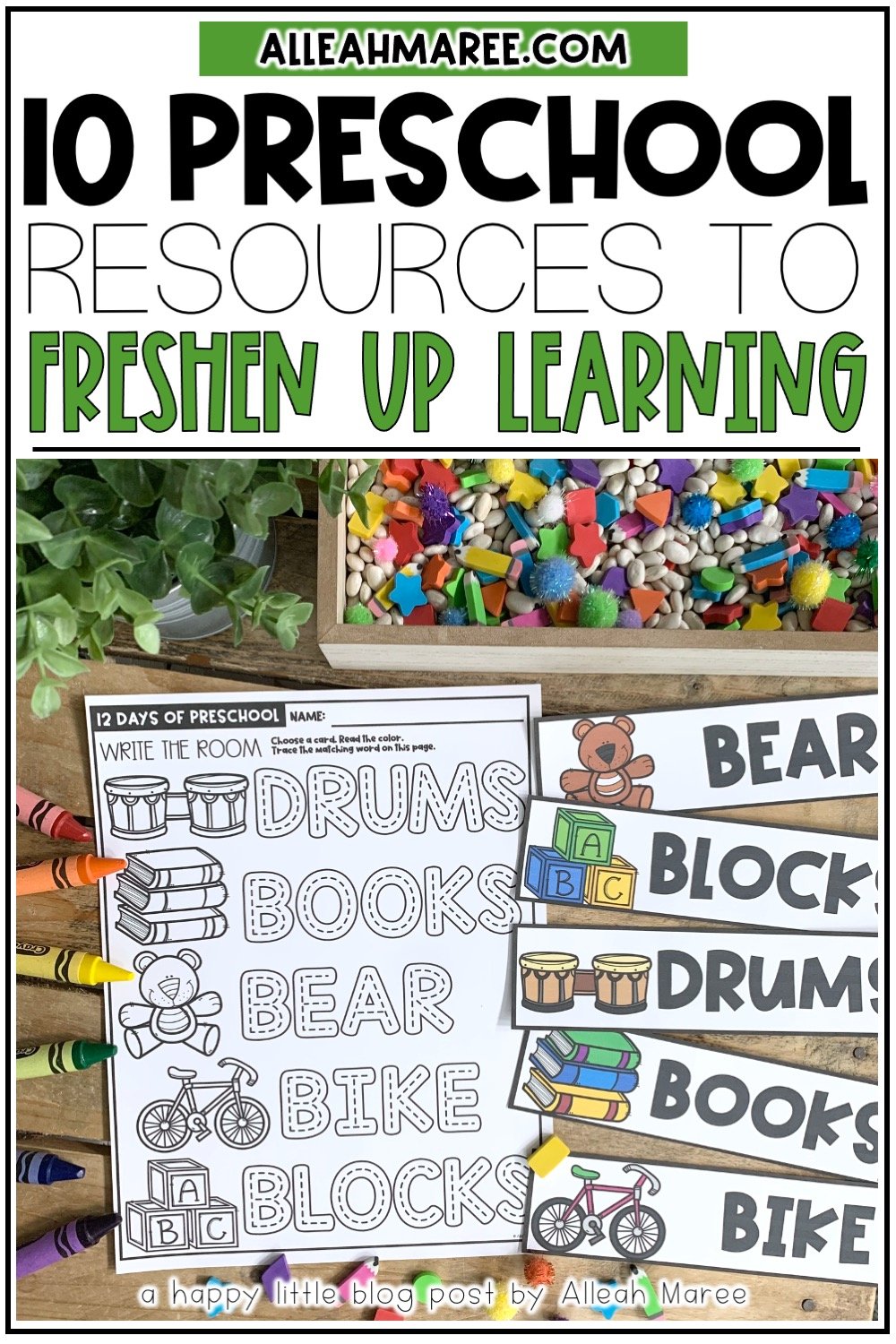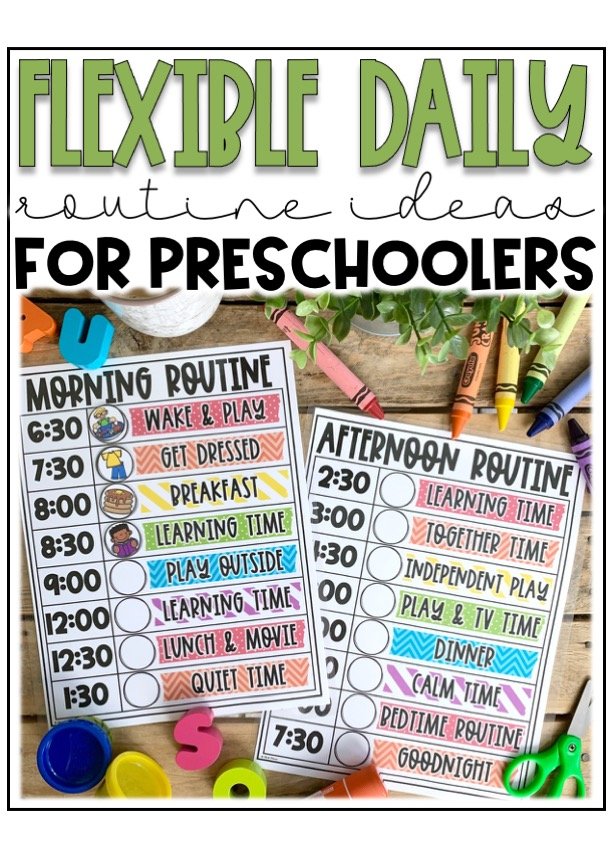10 Kinds of Preschool Resources You Need to Freshen Up the Learning
Working with preschoolers, there seems to NEVER be enough variety! Haha! Mixing up and trading out the activity manipulaties, books & stories, and general KINDS of activities available is essential to keep those little learner’s brains and bodies engaged and learning.
So, here are 10 kinds of resources my preschooler and I use to keep things fresh and fun all year long. Come see if you use any of these same ideas! There is a free sample of EVERY kind of activity included below for you to try before you buy too. 🎉
Busy boxes are a fun way for kiddos to work on learning activities that feel like playing! Busy boxes are activities for toddlers and preschoolers that all fit neatly into 4x6 photo boxes. You can toss in dry erase markers, crayons, mini erasers, or any other small manipulatives that your kids may need to work on the activities directly into the photo box and BAM, let the learning begin!
I’ve created busy boxes to include activities to practice skills like matching, tracing, sorting, identifying, creating, building, and coloring.
Little ones can use busy boxes to practice letter recognition, beginning sounds, counting, emotions, matching pictures, tracing letters and pictures, finding pictures in books, using playdough or counting cubes, shapes, and identifying numbers.
I love that busy boxes cover a HUGE variety of skills and TONS of preschool learning topics while being really fun to interact with. They’re perfect for independent centers or small group work times too!
Want a free sample? Grab this WINTER BUSY BOX or this ALPHABET BUSY BOX to see how much you and your learners will love them!
To learn more about how and why to use busy boxes, check out THIS HOW-TO POST and THIS POST.
2. BOOK COMPANIONS & ACTIVITIES
Keeping it fresh with new books is a MUST! Changing up the books you’re reading each day during learning times is also super fun because you can learn SO much from books. So, adding in some preschool book activities that go along with the books you’re reading is the perfect blend of learning and fun for little learners.
The book companions we use combine essential literacy and math skills, along with movement and fine motor skills and fun. And, each resource goes along with classic books that you have in your library and use with your learners already! There are a BUNCH of hands-on activities, interactive worksheets, and sensory bins inside, providing a simple way to check off “develop engaging activities for preschoolers" from your long to-do list. Haha!
Wondering if these book companion activities would work well for your preschoolers? CLICK HERE for a FREE SAMPLE! :)
3. SENSORY BINS
Sensory bins are a REALLY easy way to keep learning fun. I mean, most kids LOVE scooping, digging, dumping, and searching through non-messy things to find the next thing to learn with!
We create sensory bins by adding dry beans, water beads, popcorn kernels, non-sticky cereal, or mini erasers to a container. Then, toss in laminated cards to practice any skill your kids are working on! There are tons of sensory bin resource options to practice skills like sorting, counting, letters, shapes, colors, numbers, letter sounds or literally ANY other skill you might need.
You can check out all huge variety of options of sensory bins HERE. And there are a bunch of free sensory bins to try in my shop too, like THIS HUNGRY LITTLE CATERPILLAR one!
Another way to keep learning fresh and fun all year round is hands-on centers. Basically, hands-on centers are any kind of activity that has your little ones using their hands, bodies, and brains all together to complete an activity. As kids get older, activities tend to get less “hands-on” and more paper/pencil related. And, while there’s nothing wrong with paper/pencil activities, it’s usually best for younger kids to learn through playing and using their bodies to practice and internalize new skills.
SO, hands-on centers give us a fun way to play and learn WHILE using our bodies. We do a lot of sorting, matching, running back and forth from one spot to another, playing games, and singing songs to learn the early literacy and math skills that my kiddo needs to learn. These seasonally-themed centers are super fun and perfect for toddlers and young preschoolers.
Not sure how your kids will respond to hands-on centers? Try a FREE VERSION first!
Worksheets have a bad reputation. I completely agree that just plopping worksheet after worksheet in front of a student isn’t the best way to help them develop meaningful learning. However, I also completely agree that worksheets can be a helpful tool in learning and showing mastery of skills when used correctly!
I love using worksheets with little learners on occasion, especially when there is a lot of cutting, coloring, and gluing required. Why? Because little kids need a TON of practice with these skills and it develops their fine motor skills without them even knowing it. It requires good hand strength to use scissors properly and hold crayons and markers correctly. When you combine the fine motor skills of cutting and coloring and gluing with an academic concept, like letter recognition or shape matching, worksheets end up being a really beneficial activity for little ones.
These age-appropriate, no-prep worksheets require ONLY coloring and tracing (no cutting in this set) and they cover a bunch of preschool skills in every theme you’ll need for the entire year! Matching, tracing, counting, identifying letters and numbers, practicing shapes, sequencing, classifying by size, finding similarities and differences, and a whole bunch of other skills are covered in these worksheets. Combine a worksheet with an “around the room” activity or fun book and you’re teaching a great balance of skilsl!
These FREE WORKSHEETS give an example of what kinds of things are included in the bigger bundle.
This may seem obvious, but preschoolers love and need to MOVE THEIR BODIES! Our brains actually work, absorb, and retain more information when we’re moving and learning things in multiple ways. For example, if you’re learning letters, singing an ABC song AND acting out motions or signing the letters will stick more easily than JUST learning letters from a worksheet or book.
So, incorporating activities that get the kids moving around the room to learn are amazing! You can set up learning activities by placing the props, cards, or tasks around the room so kids have to GO to them before working on them, make the activity into a “scavenger hunt” so kids need to search for the next thing to do, or even just hop, jump or crawl around to the places they need to go!
Really, ANY way your little ones like to move and use their hands and bodies is a great thing to incorporate into learning times. My guy loves kicking a soccer ball and bopping beach balls in the air, so we do things like that while we learn or in between tasks.
CLICK HERE to try out an example of an around the room activity!
7. UNSTRUCTURED PLAY
Letting kids have time JUST to play without any objective is super important too! Preschoolers do some of their best learning while playing actually. Playing without any specific requirements allows them to use their imaginations, creativity, and innovation while they practice problem solving and social skills too.
Some simple ways to allow some calm, unstructured play could be:
Legos
Playdough
Dress up
Play food or kitchen
Magnatiles
Blocks
Counting cubes
Allowing short bursts of time for little ones to have no expectations about performance is an easy way to relieve any anxiety or pressure that can sometimes build up or be associated with learning times. Littles learn through play just like adults learn through experience…it’s always deeper and more meaningful when they’re doing something in real life that they enjoy! :)
CLICK HERE to grab these free indoor activity choice boards too! They can give some great inspiration for things your preschoolers may want to play with on their own.
There are SO many ways to practice fine motor skills! Whenever kids are doing something with their hands and using those muscles that control small movement, they’re practicing fine motor skills.
Adding in some fun activities to intentionally practice fine motor skills can really help preschoolers develop these skills more quickly while having so much fun. Some easy ways to practice fine motor skills include:
Play dough smashing and creating
Snapping cubes together
Picking things up with tongs
Using scissors
Practicing coloring in the lines and holding crayons and pencils correctly
Threading beads onto pipe cleaners or strings
Using clothespins
And tons more! We work on fine motor activities like this to practice those skills during our learning times.
You can test out if your learners love to learn with playdough with this FREE SAMPLE! And, for more playdough learning ideas, CLICK HERE.
9. GROSS MOTOR SKILLS
Larger, whole body movements are in the category of “gross motor skills”. Things like running, jumping, and balancing are gross motor skills that preschoolers are working on all the time. Finding fun ways to practice them in the classroom or at home gives them a productive outlet for their energy.
Need some ideas for how to strengthen those gross motor skills? Check out this free outdoor activity choice board by CLICKING HERE. Maybe you’ll find some inspiration for activities for your preschoolers!
Busy books are a sort of similar to busy boxes. The difference is that you store these kinds of activities in books (like Target blank books) instead of boxes!
These books include activities to complete using dry erase markers, crayons, and mini erasers. Busy books include activities to practice skills like matching, tracing, sorting, identifying, creating, building, and coloring also. Practice skills like letter recognition, beginning sounds, counting, emotions, matching pictures, tracing letters and pictures, finding pictures in books, using playdough or counting cubes, shapes, and identifying numbers, all in one book!
Busy books come with 2 versions of every page! One version is colored and intended to be laminated, secured to the book’s pages, and used over and over again. The other version is black and white and intended to be colored, cut apart, and glued together
I love that busy boxes cover a HUGE variety of skills and TONS of preschool learning topics while being really fun to interact with. They’re perfect for independent centers or small group work times too!
Check out the FREE rainbow one to see if you like them! Just CLICK HERE or tap the picture above!
These 10 kinds of resources are ones we use at home to keep the learning fresh and fun all year long. I hope they’ve inspired you try a new kind of learning activity that might be new to you, messier than normal, or just plain fun with your preschoolers!
Happy learning!
Wanna follow me on TPT? CLICK HERE!
Is Instagram more your thing? CLICK HERE!
To peek at my Facebook page, CLICK HERE!


















